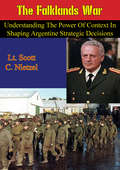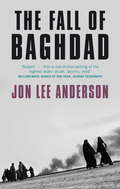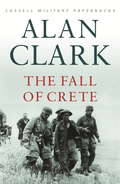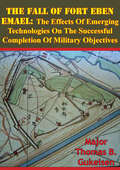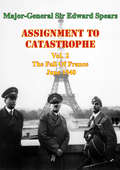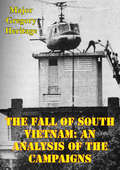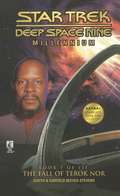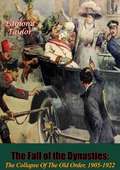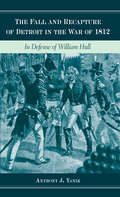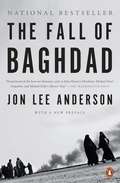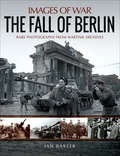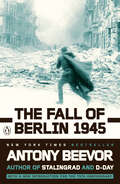- Table View
- List View
The Falklands War: Lessons for Strategy, Diplomacy, and International Law
by Alberto R. Coll and Anthony C. ArendFirst published in 1985, The Falklands War was the first comprehensive work of its kind. The book brings together a wealth of work by scholars and practitioners in the fields of diplomacy, military affairs, and international politics and law. It provides a comprehensive and objective overview of the Falklands War and the underlying crisis that continued following it. This volume is a detailed study suitable for anyone wishing to expand their knowledge of the Falklands War.
The Falklands War: Understanding the Power of Context in Shaping Argentine Strategic Decisions
by Lt. Scott C. NietzelThis thesis uses a historical case study approach to examine the impact of context on shaping decision making during the conduct of war. The case analyzed is the war between Argentina and Great Britain for control of the Falkland Islands in 1982. This thesis examines the relative strength of the belligerents' positions using the concepts of force, time and space from current operational warfare doctrine and shows that British victory in the conflict was by no means a foregone conclusion. Next, an exploration of Argentine conduct of the war highlights and discusses in detail mistakes and errors in judgment that had direct impacts on battlefield results. These decisions are then traced to the context in which they were made. It is this context, specifically the power of limited war culture and to a lesser extent the strength of the military polity as a constituency, that explains the Argentine defeat in the Falklands.
The Fall Of Baghdad
by Jon Lee AndersonFor every great historical event, at least one reporter writes an eye-opening account of such power and literary weight that it becomes joined with its subject in our minds - George Orwell's Homage to Catalonia and the Spanish Civil War; John Hersey's Hiroshima and the dropping of the first atomic bomb; Philip Gourevitch's We Wish to Inform You That Tomorrow We Will Be Killed with Our Families and the Rwandan genocide. Whatever else is written about the Iraqi people and the fall of Saddam, Jon Lee Anderson's The Fall of Baghdad will remain the classic book about the Iraq War. No subject has become more hotly politicized than the toppling of Saddam Hussein's regime, and so a thick fog of propaganda has obscured the reality of what the Iraqi people have endured and are enduring, under Saddam Hussein and now. Jon Lee Anderson has created an astonishing portrait of humanity in extremis, a work of great wisdom, human empathy, and moral clarity. In channelling a tragedy of epic dimensions through the stories of real people caught up in the whirlwind of history, Jon Lee Anderson has written a book of timeless significance.
The Fall Of Crete
by Alan ClarkThe epic story of one of the most bitter and dramatic battles fought between German and Allied forces during the whole of the Second World War. The decisive action took place within five days, and twice its outcome hung in the balance. By the third day, the number of German dead exceeded their losses in all other theatres since the outbreak of hostilities. The German parachutists were confined for supply and reinforcements to a single airstrip at Maleme, yet on this one foothold they managed to land over eight thousand men, who defeated an Allied army nearly five times as numerous. With its vivid and compelling description of the battle for Crete, Clark confirmed his reputation as a military historian first recognised with The Donkeys, his account of the British Expeditionary Force in France in 1914.
The Fall Of Crete
by Alan ClarkThe epic story of one of the most bitter and dramatic battles fought between German and Allied forces during the whole of the Second World War. The decisive action took place within five days, and twice its outcome hung in the balance. By the third day, the number of German dead exceeded their losses in all other theatres since the outbreak of hostilities. The German parachutists were confined for supply and reinforcements to a single airstrip at Maleme, yet on this one foothold they managed to land over eight thousand men, who defeated an Allied army nearly five times as numerous. With its vivid and compelling description of the battle for Crete, Clark confirmed his reputation as a military historian first recognised with The Donkeys, his account of the British Expeditionary Force in France in 1914.
The Fall Of Fort Eben Emael: The Effects Of Emerging Technologies On The Successful Completion Of Military Objectives
by Major Thomas B. GukeisenThis study details the events of 10 May 1940 at Fort Eben Emael, Belgium, and the elements which led to the successful seizure of the fort by the German military. The central focus of this thesis is the following question: Was the use of emerging technologies the key to victory at Fort Eben Emael? First, the study focuses on the technologies themselves. Secondly, this study examines the leadership and training of the German unit assigned the mission at Fort Eben Emael. Lastly, this study examines administration and personnel issues that existed for the Belgians stationed at Fort Eben Emael. This study determined that the glider did afford troops the advantage of surprise; however, the hollow charge failed to live up to its reputation as it was most effective when used in such a way that it was no different than a conventional charge. Further, the German unit's training and leadership was exemplary and contributed more to the mission's success than the technologies the unit employed. Additionally, Fort Eben Emael was faced with serious internal issues that prevented a successful defence of the fort. Therefore, this thesis concludes that emerging technologies were not the most crucial component contributing to mission success.
The Fall Of France: June 1940 (Assignment To Catastrophe #2)
by Major-General Sir Edward Louis SpearsThe German victory in France at the onset of the Second World War was sudden, brutal and brilliant; by contrast the British and French preparations were miserable, faulty, badly carried through and fraught with mistrust. In the midst of these Allied responses was the eminent liaison officer Major-General Sir Edward Louis Spears, sent by the new prime Minister Winston Churchill to be his representative to the French Prime Minister. Spears was very well suited to his role as he had seen much military service and he had served in a senior liaison capacity between the British and French armies during the First World War. Keenly observant, well connected, urbane and respected by many of the French politicians and generals, his two volume memoirs are justly famous.
The Fall Of South Vietnam: An Analysis Of The Campaigns
by Major Gregory HeritageThis monograph addresses what operational level military factors enabled the North Vietnamese Army to defeat the former South Vietnamese Army during the Vietnam War's final campaigns of 1975. The Vietnam War covered the full spectrum of conflict from terrorism, to guerrilla warfare, to a conventional war of maneuver. The final North Vietnamese offensive that defeated the South Vietnamese Army were conventional campaigns that provide opportunities for operational level planners to learn from the Vietnam experience.The methodology followed in the monograph involves first establishing a basis of information on the strategic situation and the final campaigns, and then analyzing the campaigns with Cohen and Gooch's model of military misfortune.The communists began their final offensive campaigns in December, 1974 by seizing Phuoc Long Province. In March, 1975, they continued their offensive campaigns by conducting diversionary attacks in the north threatening Pleiku and then attacking the lightly defended South Vietnamese rear area. The Communists quickly captured the Central Highlands and then raced to the sea to divide the South Vietnamese Army (ARVN). The communists blocked the South Vietnamese attempt to retrograde from the Central Highlands and destroyed the ARVN II Corps. The communists then concentrated combat power to destroy the South Vietnamese six divisions isolated in the north. After destroying these divisions, the communist seized Saigon which ended the war.The South Vietnamese suffered a catastrophic failure and lost the war because of their inability to learn, anticipate, and adapt. The South Vietnamese, failing to learn the basics of operational art, tried to defend the entire country through corps area defenses. Thus, they never defended in depth or concentrated combat power to defeat their adversary's main effort.
The Fall Of Terok Nor: Millennium (Star Trek: Deep Space Nine #Vol. 1)
by Judith Reeves-StevensContinuing the Deep Space Nine saga—an original novel from New York Times bestselling author Judith Reeves-Stevens!Bajor is in flames. The corridors of Terok Nor echo with the sounds of battle. It is the end of the Cardassian Occupation -- and the beginning of the greatest epic adventure in the saga of Deep Space 9™ Six years later, with the Federation losing ground in its war against the Dominion, the galaxy's greatest smugglers—including the beautiful and enigmatic Vash—rendezvous on Deep Space 9. Their objective: a fabled lost Orb of the Prophets unlike any other, rumored to be the key to unlocking a second wormhole in Bajoran space—a second Celestial Temple. Almost immediately, mysterious events plague the station: Odo arrest Quark for murder; Jake and Nog lead Chief O'brien to an eerie holosuite in a section of the station that's not on any schematic; and a Cardassian scientist whom even the Obsidian Order once feared makes an unexpected appearance. With all those events tied to a never-before-told story of the Cardassian withdrawal, Captain Benjamin Sisko faces the most dangerous challenge of his career. Unless he can uncover the secret of the lost Orb, what began with the fall of Terok Nor will end with the destruction of Deep Space 9...or worse.
The Fall Of The Dynasties: The Collapse Of The Old Order, 1905-1922 [Illustrated Edition]
by Edmond TaylorOriginally published in 1963, The Fall of the Dynasties covers the period from 1905 to 1922, when the four ruling houses--the Habsburg, Hohenzollern, Ottoman, and Romanov--crumbled and fell, destroying old alliances and obliterating old boundaries. World War I was precipitated by their decay and their splintered baroque rubble proved to be a treacherous base for the new nations that emerged from the war. "All convulsions of the last half-century," Taylor writes, "stem back to Sarajevo: the two World Wars, the Bolshevik revolution, the rise and fall of Hitler, and the ongoing turmoil in the Middle East. Millions upon millions of deaths can be traced to one or another of these upheavals; all of us who survive have been scarred at least emotionally by them."In this classic volume, Taylor traces the origins of the dynasties whose collapse brought the old order crashing down and the events leading to their astonishingly swift downfall.Includes numerous maps and genealogical charts."Popular history of the finest sort...an excellent book worthy to rank with Barbara Tuchman's The Guns of August and Alan Moorehead's Gallipoli."--The New York Times
The Fall Of The Dynasties: The Collapse Of The Old Order, 1905-1922 [Illustrated Edition]
by Edmond TaylorOriginally published in 1963, The Fall of the Dynasties covers the period from 1905 to 1922, when the four ruling houses—the Habsburg, Hohenzollern, Ottoman, and Romanov—crumbled and fell, destroying old alliances and obliterating old boundaries. World War I was precipitated by their decay and their splintered baroque rubble proved to be a treacherous base for the new nations that emerged from the war. “All convulsions of the last half-century,” Taylor writes, “stem back to Sarajevo: the two World Wars, the Bolshevik revolution, the rise and fall of Hitler, and the ongoing turmoil in the Middle East. Millions upon millions of deaths can be traced to one or another of these upheavals; all of us who survive have been scarred at least emotionally by them.”In this classic volume, Taylor traces the origins of the dynasties whose collapse brought the old order crashing down and the events leading to their astonishingly swift downfall.Includes numerous maps and genealogical charts.“Popular history of the finest sort...an excellent book worthy to rank with Barbara Tuchman’s The Guns of August and Alan Moorehead’s Gallipoli.”—The New York Times
The Fall and Recapture of Detroit in the War of 1812: In Defense of William Hull
by Anthony J. YanikDetails the first major U.S. setback in the War of 1812 and analyzes the background and aftermath of Hull's surrender.
The Fall of Baghdad
by Jon Lee AndersonFor every great historical event, seemingly, at least one reporter writes an eyewitness account of such power and literary weight that it becomes joined with its subject in our minds-George Orwell's Homage to Cataloniaand the Spanish Civil War; John Hersey's Hiroshimaand the dropping of the first atomic bomb; Philip Gourevitch's We Wish to Inform You That Tomorrow We Will Be Killed with Our Families: Stories of Rwandaand the Rwandan genocide. Whatever else is written about the Iraqi people and the fall of Saddam, Jon Lee Anderson's The Fall of Baghdadis worthy of mention in this company. No subject has become more hotly politicized than the toppling of Saddam Hussein's regime, and so a thick fog of propaganda, both from boosters of the war and its opponents, has obscured the reality of what the Iraqi people have endured and are enduring, under Saddam Hussein and now. For that reason alone, The Fall of Baghdadis a great and necessary book. Jon Lee Anderson has drawn on all of his reserves of stamina and personal bravery to create an astonishing portrait of humanity in extremis, a work of great wisdom, human empathy, and moral clarity. He follows a remarkable and diverse group of Iraqis over the course of this extraordinary time: from the all-pervasive fear that comes from living under Saddam's brutal, Orwellian rule to the surreal atmosphere of Baghdad before the invasion; to the invasion's commencement and the regime's death spiral down into its terrible endgame; to America's disastrously ill-conceived seizure of power and its fruits. In channeling a tragedy of epic dimensions through the stories of real people caught up in the whirlwind of history, Jon Lee Anderson has written a book of timeless significance.
The Fall of Berlin (Images of War)
by Ian BaxterA photographic history of Nazi Germany&’s last days: &“The images are well chosen—this reviewer cannot recall having seen any before.&” —The NYMAS Review By March 1945, the Red Army had closed in on Berlin. Marshal Zhukov, with almost a million soldiers and 20,000 tanks and guns at his disposal, launched his assault of the Seelow Heights. While costly, with 30,000 Russians killed, it brought the Russian Army to the gates of the capital. On April 20, Hitler&’s fifty-sixth birthday, Soviet artillery began a massive bombardment of the doomed city. The Fuhrer ordered every soldier, Hitlerjugend, and Volksstrum to fight to the death. The house-to-house fighting that followed was brutal and savage, with heavy casualties for both military and civilians. Using superb Russian and German imagery, this pictorial history describes the Russian assault and Nazi last-ditch defense of Hitler&’s capital during the final days of the Third Reich.
The Fall of Berlin (Images of War)
by Ian BaxterA photographic history of Nazi Germany&’s last days: &“The images are well chosen—this reviewer cannot recall having seen any before.&” —The NYMAS Review By March 1945, the Red Army had closed in on Berlin. Marshal Zhukov, with almost a million soldiers and 20,000 tanks and guns at his disposal, launched his assault of the Seelow Heights. While costly, with 30,000 Russians killed, it brought the Russian Army to the gates of the capital. On April 20, Hitler&’s fifty-sixth birthday, Soviet artillery began a massive bombardment of the doomed city. The Fuhrer ordered every soldier, Hitlerjugend, and Volksstrum to fight to the death. The house-to-house fighting that followed was brutal and savage, with heavy casualties for both military and civilians. Using superb Russian and German imagery, this pictorial history describes the Russian assault and Nazi last-ditch defense of Hitler&’s capital during the final days of the Third Reich.
The Fall of Berlin 1945
by Antony BeevorAcclaimed for his vivid re-creations of some of the twentieth century's most significant battles, Antony Beevor is one of the best known and respected military historians writing today. He now offers readers a gripping, street-level portrait of the harrowing days of January 1945 in Berlin when the vengeful Red Army and beleaguered Nazi forces clashed for a final time. The result was the most gruesome display of brutality in the war, with tanks crushing refugee columns, mass rapes, pillage, and destruction. Hundreds of thousands of German civilians froze to death or were massacred because Nazi officials had forbidden their evacuation. Hitler, half crazed in his bunker, issued wild orders while Stalin was prepared to risk any number of his men to seize the city before the other Allies could get there. Making full use of newly disclosed material from former Soviet files as well as from German, American, British, French, and Swedish archives, Beevor has reconstructed the different experiences of those millions caught up in the death throes of the Third Reich. The Fall of Berlin 1945 depicts not only the brutality and desperation of a city under siege but also rare moments of extreme humanity and heroism. This account also contains new revelations about the motives behind Stalin's hurried assault. Sure to appeal to all readers interested in military history and the Second World War, The Fall of Berlin 1945 promises to be the definitive treatment of the subject for years to come.
The Fall of Burma, 1941–1943 (Despatches from the Front)
by Martin Mace John GrehanDespatches in this volume include that on operations in Burma between 15 December 1941 and 20 May 1942 by General Wavell; Operations in Eastern Theatre, based on India, March 1942 to 31 December 1942 by Field-Marshall Wavell; Operations in the Indo-Burma Theatre 21 June to 15 November 1942 by Field-Marshall Auchinleck; and Operations in the India Command 1 January to 20 June 1943 by Field-Marshall Wavell.This unique collection of original documents will prove to be an invaluable resource for historians, students and all those interested in what was one of the most significant periods in British military history.
The Fall of Carthage: The Punic Wars 265-146BC
by Adrian GoldsworthyThe struggle between Rome and Carthage in the Punic Wars was arguably the greatest and most desperate conflict of antiquity. The forces involved and the casualties suffered by both sides were far greater than in any wars fought before the modern era, while the eventual outcome had far-reaching consequences for the history of the Western World, namely the ascendancy of Rome. An epic of war and battle, this is also the story of famous generals and leaders: Hannibal, Fabius Maximus, Scipio Africanus, and his grandson Scipio Aemilianus, who would finally bring down the walls of Carthage.
The Fall of Chronopolis (Gateway Essentials #15)
by Barrington J. BayleyThe mighty ships of the Third Time Fleet relentlessly patrolled the Chronotic Empire's thousand-year frontier, blotting out an error of history here or there before swooping back to challenge other time-travelling civilisations far into the future.Captain Mond Aton had been proud to serve in such a fleet. But now, falsely convicted of cowardice and dereliction of duty, he had been given the cruellest of sentences: to be sent unprotected into time as a lone messenger between the cruising timeships. After such an inconceivable experience in the endless voids there was only one option left to him.To be allowed to die.
The Fall of Crete 1941: Was Freyberg Culpable?
by Major James BlissOn 20 May 1941, Generaloberst Kurt Student's Luftwaffe XI Fliegerkorps conducted the first operational airborne invasion in history to seize Crete. Major-General Bernard Cyril Freyberg VC, 2nd New Zealand Expeditionary Force, commanded the British forces defending the island. Freyberg, forewarned of the details of the invasion, possessed numerical superiority over the enemy, but was defeated within twelve days. Freyberg, later blamed for the defeat due to his perceived faulty defensive dispositions, was dealt a losing hand from the start. His troops consisted of those that could be rescued from the failed Greek Campaign and lacked sufficient weapons, communications, and transport to conduct the defense. Despite the best efforts of the Royal Navy, overwhelming Luftwaffe air superiority in the absence of the Royal Air Force isolated Crete and the relentless drive of the attacking German forces captured it. Poor tactical leadership by Freyberg's subordinate commanders and their failure to prosecute his operational plan led to defeat by the barest margin. While a tactical loss, Freyberg's destruction of the 7th Flieger Division resulted in Hitler never considering an operational airborne assault again. Freyberg, although accepting responsibility for the defeat, should not be held entirely culpable for the loss of Crete.
The Fall of Dragons (The Traitor Son Cycle #5)
by Miles CameronMiles Cameron is the master of intrigue and action-packed battles in this epic tale of magic and mercenaries, war, depravity, and politics, the final book of the Traitor Son Cycle.In the climax of the Traitor Son Cycle, the allied armies of the Wild and the Kingdoms of men and women must face Ash for control of the gates to the hermetical universe, and for control of their own destinies. But exhaustion, treachery and time may all prove deadlier enemies.In Alba, Queen Desiderata struggles to rebuild her kingdom wrecked by a year of civil war, even as the Autumn battles are fought in the west. In the Terra Antica, The Red Knight attempts to force his unwilling allies to finish the Necromancer instead of each other. But as the last battle nears, The Red Knight makes a horrifying discovery. . .all of this fighting may have happened before.
The Fall of Eben Emael - Belgium 1940
by Chris Mcnab Peter DennisIn early May 1940, the fortress of Eben Emael was a potent sentinel over the Belgian-Dutch borderlands. The fortress covered 75 hectares on the surface, had 5km of tunnels underground and was studded with bunkers, gun turrets and casemates. Add a garrison of 1,200 men and the natural protection of 60m-high canal walls, and Eben Emael gave the impression of near-impregnability. Yet on 10 May just 78 elite airborne soldiers managed to defeat this fortress in an operation of unprecedented tactical skill. Deployed by glider onto the very top of the fortifications, they utilized elite training, fast movement and specialist explosives to destroy many of the gun positions and trap much of the garrison within the fortress. Simultaneously, three other assault detachments conducted high-risk glider operations to capture critical bridges over the Albert Canal. By the end of 11 May, following the arrival of German infantry reinforcements, Eben Emael was in German hands. This Eben Emael RAID title tells the complete, fascinating story of this unique action.
The Fall of English France 1449-53
by David Nicolle Graham TurnerFor the overwhelming majority of people outside the French-speaking world the Hundred Years War consisted of a sequence of major English victories, above all Crécy, Poitiers and Agincourt. The only significant victor or 'hero' on the French side was Joan of Arc, and she ended up being burned at the stake. Yet somehow the war ended in a French victory and with England's martial energies being turned against itself in the Wars of the Roses. This book is intended to provide some balance. It will describe the campaign that brought the Hundred Years War to a close, with English possessions being confined to Calais and the Channel Islands. It will also explain how the somewhat unprepossessing and unmartial King Charles VII of France succeeded where his predecessors had failed. The campaign consisted of more than battles, of course, but it was marked by two major victories - at Formigny in 1450 and at Castillon in 1453. Formigny is of special interest because it saw French cavalry defeat English archers, in effect a reversal of Crécy, Poitiers and Agincourt, and could be interpreted as one of the last 'medieval' battles. Castillon is of interest because it was a victory of gunpowder artillery in fixed positions over a traditional medieval assault by mixed infantry and cavalry, and thus could be interpreted as one of the first 'modern' battles.
The Fall of France 1940
by Andrew ShennanOffering a fresh critical perspective on this momentous event, Andrew Shennan examines both the continuities and discontinuities that resulted from the events of 1940. The main focus is on the French experience of the war, but this experience is framed within the larger context of France's - and Europe's - protracted mid-twentieth century crisis.
The Fall of France in the Second World War: History and Memory
by Richard CarswellThis book examines how the fall of France in the Second World War has been recorded by historians and remembered within society. It argues that explanations of the fall have usually revolved around the four main themes of decadence, failure, constraint and contingency. It shows that the dominant explanation claimed for many years that the fall was the inevitable consequence of a society grown rotten in the inter-war period. This view has been largely replaced among academic historians by a consensus which distinguishes between the military defeat and the political demise of the Third Republic. It emphasizes the contingent factors that led to the military defeat. At the same time it seeks to understand the constraints within which France’s policy-makers were required to act and the reasons for their policy-making failures in economics, defence and diplomacy.

